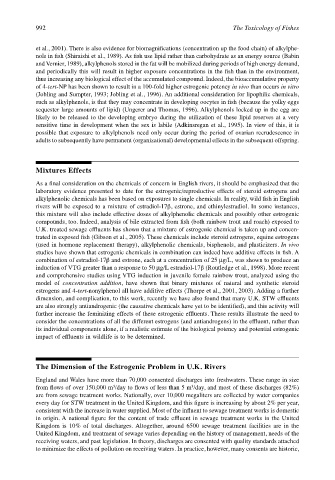Page 1012 - The Toxicology of Fishes
P. 1012
992 The Toxicology of Fishes
et al., 2001). There is also evidence for biomagnifications (concentration up the food chain) of alkylphe-
nols in fish (Shiraishi et al., 1989). As fish use lipid rather than carbohydrate as an energy source (Babin
and Vernier, 1989), alkylphenols stored in the fat will be mobilized during periods of high energy demand,
and periodically this will result in higher exposure concentrations in the fish than in the environment,
thus increasing any biological effect of the accumulated compound. Indeed, the bioaccumulative property
of 4-tert-NP has been shown to result in a 100-fold higher estrogenic potency in vivo than occurs in vitro
(Jobling and Sumpter, 1993; Jobling et al., 1996). An additional consideration for lipophilic chemicals,
such as alkylphenols, is that they may concentrate in developing oocytes in fish (because the yolky eggs
sequester large amounts of lipid) (Ungerer and Thomas, 1996). Alkylphenols locked up in the egg are
likely to be released to the developing embryo during the utilization of these lipid reserves at a very
sensitive time in development when the sex is labile (Adkinsregan et al., 1995). In view of this, it is
possible that exposure to alkylphenols need only occur during the period of ovarian recrudescence in
adults to subsequently have permanent (organizational) developmental effects in the subsequent offspring.
Mixtures Effects
As a final consideration on the chemicals of concern in English rivers, it should be emphasized that the
laboratory evidence presented to date for the estrogenic/reproductive effects of steroid estrogens and
alkylphenolic chemicals has been based on exposures to single chemicals. In reality, wild fish in English
rivers will be exposed to a mixture of estradiol-17β, estrone, and ethinylestradiol. In some instances,
this mixture will also include effective doses of alkylphenolic chemicals and possibly other estrogenic
compounds, too. Indeed, analysis of bile extracted from fish (both rainbow trout and roach) exposed to
U.K. treated sewage effluents has shown that a mixture of estrogenic chemical is taken up and concen-
trated in exposed fish (Gibson et al., 2005). These chemicals include steroid estrogens, equine estrogens
(used in hormone replacement therapy), alkylphenolic chemicals, bisphenols, and plasticizers. In vivo
studies have shown that estrogenic chemicals in combination can indeed have additive effects in fish. A
combination of estradiol-17β and estrone, each at a concentration of 25 µg/L, was shown to produce an
induction of VTG greater than a response to 50 µg/L estradiol-17β (Routledge et al., 1998). More recent
and comprehensive studies using VTG induction in juvenile female rainbow trout, analyzed using the
model of concentration addition, have shown that binary mixtures of natural and synthetic steroid
estrogens and 4-tert-nonylphenol all have additive effects (Thorpe et al., 2001, 2003). Adding a further
dimension, and complication, to this work, recently we have also found that many U.K. STW effluents
are also strongly antiandrogenic (the causative chemicals have yet to be identified), and this activity will
further increase the feminizing effects of these estrogenic effluents. These results illustrate the need to
consider the concentrations of all the different estrogens (and antiandrogens) in the effluent, rather than
its individual components alone, if a realistic estimate of the biological potency and potential estrogenic
impact of effluents in wildlife is to be determined.
The Dimension of the Estrogenic Problem in U.K. Rivers
England and Wales have more than 70,000 consented discharges into freshwaters. These range in size
3
3
from flows of over 150,000 m /day to flows of less than 5 m /day, and most of these discharges (82%)
are from sewage treatment works. Nationally, over 10,000 megaliters are collected by water companies
every day for STW treatment in the United Kingdom, and this figure is increasing by about 2% per year,
consistent with the increase in water supplied. Most of the influent to sewage treatment works is domestic
in origin. A national figure for the content of trade effluent in sewage treatment works in the United
Kingdom is 10% of total discharges. Altogether, around 6500 sewage treatment facilities are in the
United Kingdom, and treatment of sewage varies depending on the history of management, needs of the
receiving waters, and past legislation. In theory, discharges are consented with quality standards attached
to minimize the effects of pollution on receiving waters. In practice, however, many consents are historic,

